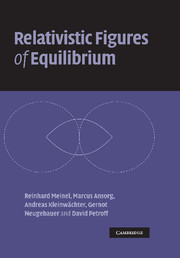Book contents
- Frontmatter
- Contents
- Preface
- Notation
- 1 Rotating fluid bodies in equilibrium: fundamental notions and equations
- 2 Analytical treatment of limiting cases
- 3 Numerical treatment of the general case
- 4 Remarks on stability and astrophysical relevance
- Appendix 1 A detailed look at the mass-shedding limit
- Appendix 2 Theta functions: definitions and relations
- Appendix 3 Multipole moments of the rotating disc of dust
- Appendix 4 The disc solution as a Bäcklund limit
- References
- Index
4 - Remarks on stability and astrophysical relevance
Published online by Cambridge University Press: 22 October 2009
- Frontmatter
- Contents
- Preface
- Notation
- 1 Rotating fluid bodies in equilibrium: fundamental notions and equations
- 2 Analytical treatment of limiting cases
- 3 Numerical treatment of the general case
- 4 Remarks on stability and astrophysical relevance
- Appendix 1 A detailed look at the mass-shedding limit
- Appendix 2 Theta functions: definitions and relations
- Appendix 3 Multipole moments of the rotating disc of dust
- Appendix 4 The disc solution as a Bäcklund limit
- References
- Index
Summary
In general, a relativistic figure of equilibrium as calculated in the previous chapters is to be expected to exist in nature only if it is in stable equilibrium. Therefore, in addition to other aspects, like realistic equations of state, magnetic fields and initial conditions, the investigation of stability properties is very important for identifying configurations that might be astrophysically relevant. Acomplete stability analysis of relativistic figures of equilibrium is extremely difficult. Moreover, the stability depends on matter properties like viscosity and thermal conductivity, which are unimportant for the equilibrium state itself and therefore do not need to be specified in this book. Our intention, as expressed in the preface, is to ‘place emphasis on the rigorous treatment of simple models instead of trying to describe real objects with their many complex facets’ and, consequently, an extensive treatment of stability questions is beyond the scope of this book. Nevertheless, in the following we will discuss some aspects of stability of rotating fluid configurations in general relativity.
Stability with respect to axisymmetric perturbations
Friedman et al. (1988) have shown that a version of the turning-point method going back to Poincaré (1885), who investigated the stability of Newtonian equilibrium configurations (cf. Subsection 3.3.1), can be used to locate points along sequences of relativistic figures of equilibrium at which secular instability with respect to axisymmetric perturbations sets in, see also Thorne (1967).
- Type
- Chapter
- Information
- Relativistic Figures of Equilibrium , pp. 177 - 180Publisher: Cambridge University PressPrint publication year: 2008



